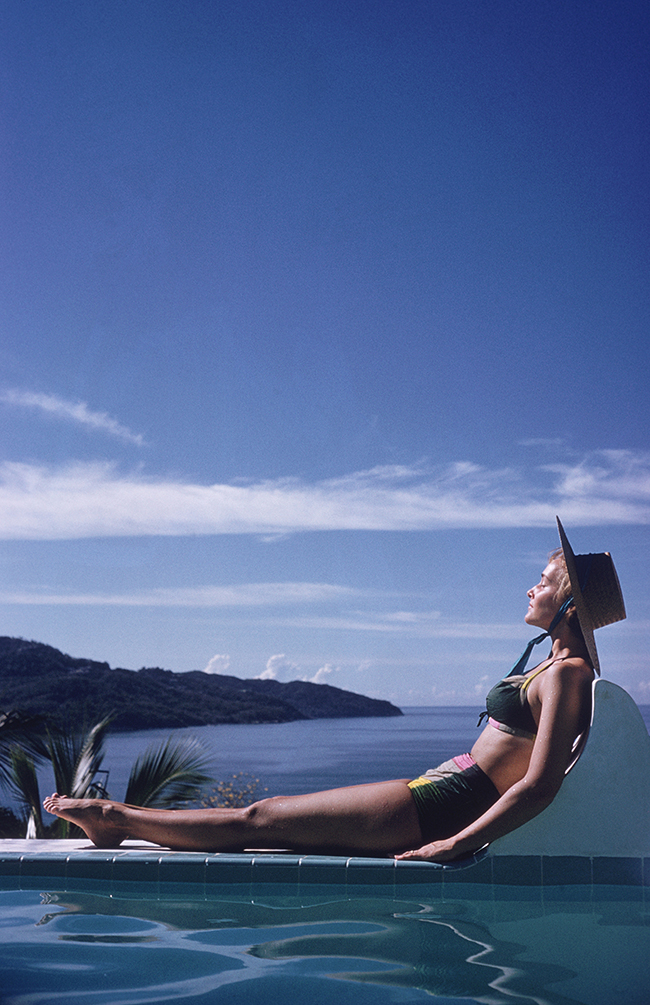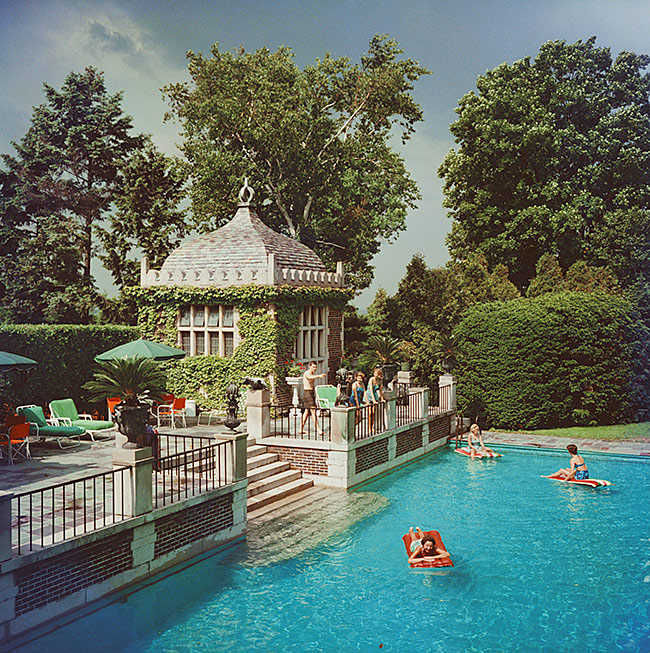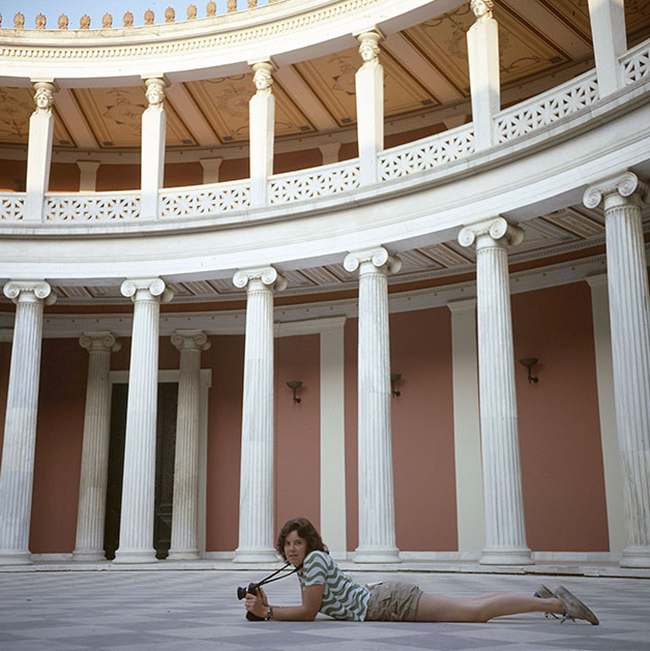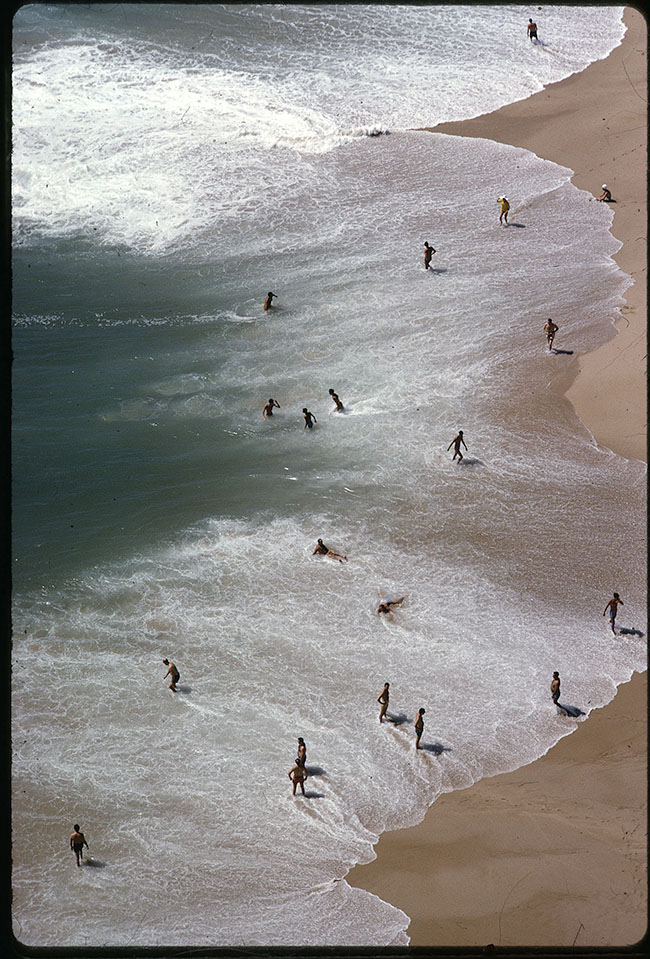Slim Aarons: A Curated Life
The Story Behind the Glamour
Interview by Lauri Lyons
Iconic photographer Slim Aarons was famous for documenting the quintessential good life all around the world. Now his daughter and former photo assistant, Mary Aarons, is revealing her father’s techniques for creating the perfect shot, as well as a good life of her own.

A Sophisticated Snooze: Slim Aarons in Greece.
Where was your father, Slim Aarons, originally from?
Mary Aarons: He was born in New York City.
Did he serve in the military before becoming a professional photographer?
Yes, he was in the Army during World War II. He was a part of the press corps. He started out in the darkroom and then worked his way up to being a photographer.
Was the war his first opportunity to travel outside of the U.S.?
I’m sure it was. I don’t think anyone really traveled outside of the U.S. at that point.
Where was he stationed?
North Africa (what would be considered Tunisia and Algeria now) and Rome. Rome was really his favorite spot. At one point he also went to London and Paris, and then all throughout Europe. His letters remind me very much of that film The English Patient.The soldiers were in some beautiful places, but some pretty horrid things were going on around them.
Did he ever talk to you about what it was like being a photographer during war time, and how did he develop his skills?
He was working for Yank Magazine (the Army weekly). It was his first magazine and he was working with a group of guys and some women, who went on to pretty illustrious careers in journalism. War time back then was a little bit different than it is now. They felt a certain type of camaraderie. They were saving each other when they had to, but they also went to the pubs and hung out with Red Cross nurses. They were young guys doing what young guys do.

1958: Swimsuited revellers enjoy a glass of wine outside the Carlton Hotel, Cannes.
When he came back to the States and started doing commercial work for the major magazines,
how do you think he developed such close, personal relationships with his subjects?
I think it was his charm; he was a special kind of guy. He was very worldly. I think the war in Europe, to certain extent, was very different, than the types of places where we are in war now. Back then soldiers were stationed in long standing capital cities, that to some extent still had a certain kind of lifestyle. My father became familiar with being a sort of a well traveled, cultured guy. He had access to the best of the best. He was exposed to a lifestyle, and he realized there was a world beyond New York City and the Northeast.

1977: At the 16th hole on Pebble Beach golf course, singer and film star Bing Crosby (in red)
and A Thomas Taylor.
Looking at your father’s photographs, it seems he was able to cross an emotional boundary, where he really became one of the group.
I think that may be how somebody may perceive it now, but he certainly wasn’t one of the group. He was very clear that he was not of the same social class as the people he photographed and would never pass himself off as. He was a journalist, it was his job. He just really had a certain look. He acted a certain way so he didn’t stick out. He wanted to be able to come back the next day, if he had to. He did the right thing: he dressed properly, he talked properly, he acted properly, he knew the boundaries. By no means was he ever pretending or passing himself off as being of the class or a lifestyle, he was seeing around him. He was always very, very humble.

Photographer Inge Morath, sunbathes by a swimming pool next to the sea in Acapulco.
Did he have a quality about himself that allowed his subjects to be themselves, as opposed
to their personas?
Yes, he was charming. He had a way about him that was really friendly, honest and open. Also, people were fascinated by his camera. The camera can be your calling card, people always like to find out where people have been. It’s a good conversation starter and he had much to talk about. They want to see the camera, they want you to see their camera. Right away you’re on a leveled playing ground.

Poolside Glamour – A desert house designed by Richard Neutra for Edgar J. Kaufmann, Palm Springs, California, January 1970.
Growing up what did you think about the photos and stories he shared about his experiences with glamorous people?
He was my dad and it was his job. I probably saw a lot of photographs that I should have been more impressed by, but I was busy with my own life. He would be up for days when he got home from an assignment. He would have to wait two to three days for the film to get processed, then he would dive right into editing. For part of my childhood his little study was right next to my bedroom and he would be up all night looking at pictures. I heard all these names, but I didn’t know anything different. I never had a picture of his on my wall. I look at people’s homes now, with his work, and think maybe I should do that! I need to get some of these pictures! I do have a lot of the pictures, but I’ve never framed them.
Did he encourage you to photograph, or did you start photographing on your own?
I would say probably on my own. I always had access to cameras, and if I wanted a camera he would get it for me. I didn’t have to wait for Christmas. He was critical of me, maybe a little more critical than teachers I had, but that’s just a dad maybe forgetting who he’s talking to just a teenage girl, not a professional.

How did you become his photo assistant?
I think it was just a natural evolution. If your daughter has two to three months off in the summer and is too young to get a real job, it’s a good opportunity to help her. He said “Let’s go together”. It became the defacto, it was better than babysitting.
While you were working with him, what were some of the practical photography tasks he would have you do as his assistant?
I called for taxis, made sure that we got up on time and were out of the house on time, and had a ride to the place we were going. I wrote captions and took down the names of who’s who, and make phone calls. I was the one who would move things around. My dad would say “ Mary, move that potted plant”, “Mary, can you move the couch six inches?”, “Mary, get the dog to behave”, “Make sure the kid doesn’t cry”. I helped choose people’s outfits, if he didn’t like what they were wearing. I would go through their closets and help them pick a better dress. He would say, “Can you hold this light stand up higher? Get up on the ladder”. I did a lot of stuff that you could call “styling”.

Circa 1960: Mrs. A. Watson Armour III (Jean Schweppe) with friends and family enjoying the pool on their estate at Lake Forest, Illinois. A Wonderful Time.
How did you personally process the world of beautiful people and homes you were stepping into?
There was a context. I always knew where we were going, who they were, why we were there, what the story was about, or why they were important or cool. I was told to behave and remember I was there on business. When we went to shoot a horse auction in Rancho Santa Fe, California, he told me to make sure I sit on my hands, so I would not mistakenly buy a million dollar race horse! That’s what any dad would say to a child, whether the child was five years old or thirty. I just stayed in the background and didn’t make a fuss, it wasn’t about me.
What were his “must haves” in regards to the gear he would pack for assignments?
He always carried a Halliburton hard metal suitcase, long before they were in vogue. Now they are kind of chic. He kept it inside of a T. Anthony, suitcase because he didn’t want it to stand out. He didn’t want people to know there were cameras inside. He was carrying around a lot of equipment that was his life’s blood. He just wanted to pass himself off as just carrying a really heavy suitcase. This was before you had to go through all of the security we go through now.
My dad was a champion packer. He had a uniform all the time. He wore a khaki colored trench coat. He always had a blazer with him, and a grey suit. He only wore a black knit tie, a navy blue pullover, a pale blue Brooks Brothers shirt, and khakis or grey flannel pants. That’s about it, he didn’t have a lot. I’m packing a suitcase right now for a three week trip and I’ve got a thousand different things in all sorts of patterns, he wasn’t like that.

What were some of your favorite memories of traveling with your dad?
We always had a lot of fun. He loved to do what you’re “supposed” to do, by that I mean go somewhere for the ultimate experience. I was in college in Europe when I was about to turn 21. He told me if I could get myself to the Frankfurt airport from Nice, where I was going to school, and meet him at 9am at the airport, I could come on an assignment with him to Austria.
I showed up at the Frankfurt airport and I think he was a bit surprised that I figured out how to do that all by myself. We went to Vienna for my 21st birthday and we went to see Rudolph Nureyev dance Swan Lake. We also saw the Lipizzan stallions at the Spanish Riding School. I guess we were tourists, we did the quintessential things to do in any city. When we went to Rome or Athens, we went to the best museums. We went to see the major Velazquez paintings, we ate at the best restaurants, we stayed at the best hotels. We also did the off the beaten path kinds of stuff too, the secret pathways.

What were the “secret pathways”?
He always knew these hidden places. In Athens we always went to a little outdoor eating and dancing place, with cute little lights. We would eat dinner and dance. Then we went to different islands with ruins, churches, and hole-in-the-wall restaurants, little things like that. In London we would go to rare books stores, and his favorite little pubs that weren’t necessarily touristy ones, but the ones that journalists frequented, that he knew from a friend. He always went to antique stores. He had favorite antique stores in every city, so we would go there and look for little decorative objects that he would bring home. He was a great collector.
What did he love to collect?
He loved the Baedeker travel books, they are classic 100 year old travel books. He had a complete set of Baedekers that were quite old and hard to find. He also collected vintage porcelain with the royal family. Today, it would be a cup for Princess Charlotte or something when somebody’s born. When there’s a royal wedding they always do a commemorative cup or mug. He had a collection of those. We have beautiful heavy metal birds from China, screens from Japan. I have ceramic beer steins with our names on them from Germany. Some of them were souvenirs, but not crappy souvenirs. They were really nice souvenirs that lasted fifty years. He also bought me Bard dolls. I have a suitcase full of aged Bard dolls, they were my treasures as a kid.

Looking back on the time you spent with him on these trips, and helping him with his work,
how do you feel that enriched your life?
I certainly had the opportunity to go to a bunch of different places for 3 to 4 week trips, stay in really nice hotels, see fabulous museums, and had the opportunity to meet certain people, but it was a job.
We were up at the crack of dawn. We worked all day and we worked hard. We were on the plane the next day to go to the next place. In every place we usually had one day off, but we were there for four or five days. It was really, really hard work. We were never lying on the beach, we never did that. There was one picture of me, where I had the opportunity to water ski off the back of a fancy boat. I didn’t have a bathing suit, and my dad didn’t want me to miss the experience, so he let me wear a pair of his speedos, which I wore with a t-shirt and no bra!

Why do you feel your father’s work has become so iconic?
I think the place and settings just look good. The color looks good and the people look good. For the most part the pictures don’t look dated. The era he shot in is popular once again. He photographed people when they were looking their best. He wasn’t shooting Hollywood stars that were overly made up, nor was he shooting anybody grungy, in a grungy type of setting. Everybody just looks good, a take on life at its best. After the war he wanted to shoot beautiful people, doing beautiful things, in beautiful places.
It’s really the composition, the color, the style of the faces, the looks that he was able to get. The smile he got people to put on were all kind of uplifting and happy without being staged. To some extent there is the fact that he photographed on his own or with somebody like me, and not with a crew of a thousand people putting together a shot. It was a much more contained, personal, at home experience. It wasn’t a big production and I think that shows in the photos.
Why did you start to create the travel photography workshops?
Exclusive Resorts, a private club for luxury vacations,contacted me about a year ago and asked me if I wanted to be a part of their Destinations in Focus travel photography program. They explained to me about their company and their relationship with Leica Cameras. Leica was a big part of my dad’s career. He used their cameras and we even had a dog named Leica.
What Exclusive Resorts offers to their members, is very similar to the sort of lifestyle my dad photographed in terms of the kinds of places he went, and the kind of homes that he photographed. It’s sort of these once in a lifetime travel experiences that the members enjoy. They are very akin to the kind of experiences that the people my dad photographed were having. There was a real synergy that was aligned with what my dad was involved with and represented. The workshops are all about photography, it’s about travel, it’s about being a collector, and it’s about what he and I did together when we were on one of those jobs or even when he was there without me.
It wasn’t just because I was along that he would go to see the Mona Lisa in Paris. He would always go see the Mona Lisa and the other paintings at the Louvre. It was always about collecting memories, collecting experiences, and experiencing the best level of travel that he was able to enjoy because of his job. The people he photographed also really enjoyed the best level of travel.
You’ve already done a workshop in Las Vegas and the California workshop will take place in April?
Yes, Las Vegas was fabulous. We stayed in beautiful Exclusive Resorts hotel apartments, but you don’t need to be an Exclusive Resorts member or professional photographer to sign up. We had a great group of people and full access to all the Leica equipment, plus two Leica academy instructors and myself teaching the workshop. We had a model and captured pool shoots with her, went to the neon graveyard (where all Vegas neon signs go to die), and had an early morning balloon adventure to capture the incredible Vegas landscape. We gave photo assignments, reviewed work, and learned how to edit.
We focused on the landscape and took pictures of each other as part of the workshop. We gave assignments, I participated and I was one of the instructors. We all came back and we had our assignments and the shots we had done as part of the workshop. We learned from the leica academy guys how to edit. I gave presentations about how my dad would approach getting shots. When we were out there shooting I would say, “Ooh I think my dad would have done it this way”. It was an opportunity for me to remember what I learned on the ground working with him.
For the California workshop, there will be a Leica gallery exhibit in West Hollywood. The next day we’ll get into Airstream trailers and go glamping. The group will start traveling in Malibu and then go up the Pacific Coast Highway to Santa Barbara. There will be a session about shooting at the beach, and perhaps shooting at the Mission in Santa Barbara.

Did you feel Slim’s presence at the workshop, looking over your shoulder or talking in your ear?
You know, during this entire process I have. At the gallery opening at the New York Leica store, under one roof were his iconic photos with lesser known personal images which included shots of family members. At the exhibit that night there were a lot of family, friends and former colleagues. I knew my dad so wanted to be there. It was everything that he loved and it was happening in New York at the Leica store! He needed to be there. For the California workshop, were going to some of his favorite places. He’ll be there looking down somehow.
photo credits: by Slim Aarons/Getty Images
